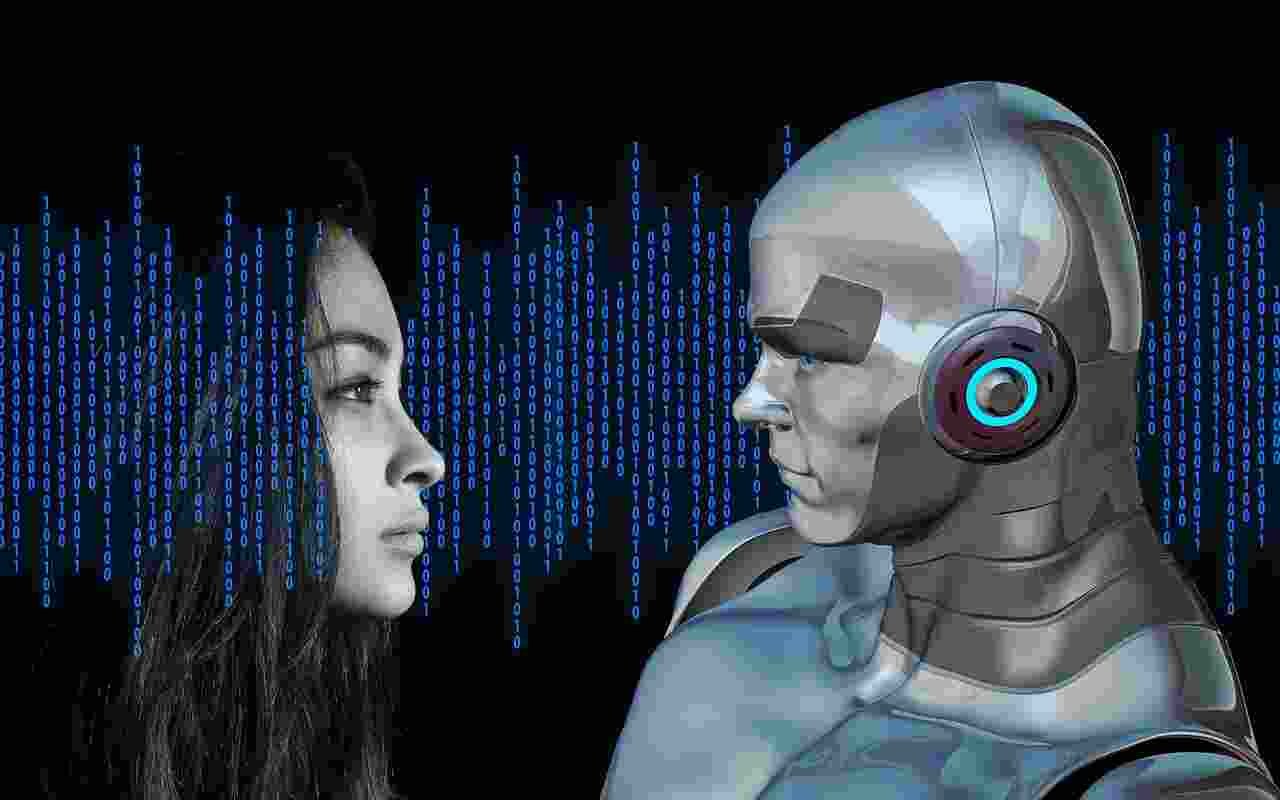What is Artificial Intelligence (AI)?
Artificial Intelligence (AI) consists of implementing a number of techniques aimed at enabling machines to imitate a form of real intelligence. AI is being implemented in a growing number of application areas.
The concept was born in the 1950s thanks to the mathematician Alan Turing. In his book Computing Machinery and Intelligence, the latter raises the question of providing machines with a form of intelligence. He then describes a test known today as the “Turing Test” in which a subject interacts blindly with another human, then with a machine programmed to formulate sensible answers. If the subject is unable to tell the difference, then the machine has passed the test and, according to the author, can truly be considered “intelligent”.
AI can be categorized as weak or strong. Weak AI, or narrow AI, is an artificial intelligence system designed and trained for a particular task. Thus, virtual personal assistants like Apple’s Siri are a weak form of AI. As for strong AI, or artificial general intelligence, it has human cognitive capacities. When presented with an unknown task, a good AI system is able to find a solution, without human intervention.
Hardware, software and personnel costs for artificial intelligence can be high. So many vendors are including AI components in their standard offerings as well as access to AIaaS (Artificial Intelligence as a Service) platforms. AIaaS allows individuals and businesses to experiment with artificial intelligence and test multiple platforms before committing. The most popular artificial intelligence cloud computing offerings include Amazon AI services, IBM Watson Assistant, Microsoft Cognitive Services, and Google AI services.
AI, some examples of use
Artificial vision, for example, allows the machine to precisely determine the content of an image and then classify it automatically according to the object, color or face identified.
Algorithms are able to optimize their calculations as they perform processing. This is how anti-spam filters become more and more effective as the user identifies an unwanted message or, on the contrary, processes false positives.
Voice recognition is on the rise with virtual assistants capable of transcribing the words expressed in natural language and then processing requests either by responding directly via voice synthesis, or with instant translation or even by making a request relating to the order.
Examples of AI
- Chat: https://openai.com/
- Zoolingua to talk with your dog or cat
- OPTIMA to help surgeons
- Air Shepherd and Neurala to protect endangered species
Artificial intelligence, infinite potential
The possibilities of AI seem to be growing exponentially.
In recent years, we have moved from a simple chatbot to using artificial intelligence to help make crucial decisions, whether in the medical or military field.
With such diverse fields of application, the need for data experts is felt in many sectors of activity. This is particularly the case for banking and insurance players who have not hesitated to prepare for the jobs of tomorrow, with specialized schools and training to become a Data Analyst, for example.
What is artificial intelligence used for?
The fields of application of artificial intelligence are numerous. It is present in the cameras of smartphones. In night mode, it allows you to adapt the colorimetry to the environment, and to restore a lit facade to its original radiance to reproduce it faithfully on your shot.
In photography
AI also intervenes to detect specific scenes, to stabilize the device or to optimize zoom precision. Facial recognition is another technology made possible by artificial intelligence. It is used to recognize the user of a mobile phone, but also on a larger scale to identify people, for example in airports.
Multiple fields
AI is also introduced in the military field (for example for drone decision-making), in the finance sector (assessment of the risks of an operation such as the granting of a mortgage), in medicine (diagnosis eye conditions), robotics, video games (animation of non-player characters), transport (traffic management in public transport) and industries (implementation of maintenance systems to deal with production problems).
Analyze texts
Whether oral or written, artificial intelligence is getting better and better at understanding and using language to automatically respond to various requests. Today, it is used, for example, to manage customer relations, on the Internet or by telephone. Conversational agents or chatbots in English are intelligent systems that manage to maintain a conversation in natural language. They are based on different technological bricks: recognition of text, speech, facial expressions, etc.
To model knowledge to help decision-making
artificial intelligence makes it possible to code a set of knowledge, to reproduce a standard reasoning and to use this information to make decisions. For example, it is now possible, from multiple and complex data, to help doctors offer personalized treatments for prostate cancer.
To produce knowledge thanks to “machine learning” or automatic learning
Thanks to artificial intelligence, the machine becomes capable of identifying trends or correlations in a very large volume of data, by adapting its analyzes and behaviors and thus create their own knowledge based on accumulated experience.
This makes it possible to offer very fine predictions on energy consumption, the evolution of the behavior of a machine or a building.
The predictive rules that are derived from it are only the result of what has already happened; they are not general laws.
Analyze images or scenes in real time
Recognize manufacturing defects or detect faces. For example, some factories have robots that detect technical problems, defects in real time and correct or stop production. To be able to analyze a very large quantity of visual data simultaneously, researchers are developing software based on deep neural networks, which allow computers to acquire learning capabilities (deep learning).
To carry out actions
For example, artificial intelligence makes it possible to imitate and perfectly reproduce certain human gestures such as administering a vaccine via a robotic hand.
Stability AI launches its algorithms to attack music industries
The British start-up is launching a generative artificial intelligence service for musicians. Called “Stable Audio”, it produces songs based on a written order.
The British start-up Stability AI, which made itself known with its artificial intelligence-based image generator Stable Diffusion, is launching its generative musical AI service. Called “Stable Audio”, it allows you to create music by indicating in English the style (hip-hop, blues, etc.), the atmosphere (groovy, melancholic, etc.), the instruments or the desired tempo.
The algorithms feed on music and metadata from a partner company, AudioSparx (a music library of independent artists) to create the requested track. According to the MusicAlly website, AudioSparx gave its members the opportunity to refuse to participate. Around 10% of them have taken it, the others will receive a share of the income generated. Intellectual property rules are therefore respected.
According to Stability AI, the service would be very good at generating rhythm lines, but less so for melodies, which makes it less efficient on jazz and classical. For the moment. Two versions of the service are offered. The first, free, produces short pieces of 45 seconds, downloadable and intended for personal use. The second, “pro”, allows, for $11.99 per month, to generate longer titles (90 seconds) and give them commercial use, to accompany projects (videos, films, video games, advertising, etc.) or products (software, applications, etc.).
A creative assistant
Stable Audio is aimed at musicians, who can use it as an assistant to produce “samples” quickly and on instruments that they do not master. “The most exciting thing about it is that musicians use it to create any sample they can think of, whether it’s a drum beat or a crazy mix of instruments, to use in their own music,” Ed Newton-Rex, vice president of audio at Stability AI, told MusicAlly. The service may be of interest to a broader creative community, in particular content creators who want to accompany their videos with a soundtrack or professionals who are looking for a particular sound (not necessarily musical) for commercial use.
Other generative musical AI platforms were launched this year, at the experimental stage, such as MusicLM, developed by Google, and MusicGen, offered by Meta. Some services are already in commercial operation, such as Aiva or Soundful. Faced with this technology which could disrupt artistic creation, part of the music industry remains on its guard, worrying about respect for copyright but also about the congestion of streaming platforms with automatically generated pieces.
How does artificial intelligence work?
Machines with artificial intelligence memorize behaviors. This work of memorization allows them later to solve problems, and to act correctly when faced with such and such a situation. This learning is carried out using databases and algorithms. This complex work helps the machine to measure the importance of a problem, to sift through possible solutions and similar past situations in order to act well.
It is actually a sophisticated and very powerful system of statistics which lead the machine to make a decision or to have the expected behavior. To measure its degree of intelligence, a machine is subjected to the Turing test. This test is named after the inventor of AI, Alan Turing. This British mathematician was one of the first to wonder, in 1950, if a machine was capable of thinking. The Turing test consists of conversing with the machine and asking it to create something with specific criteria that it must respect.
Quantum Machine Learning | Power of Data, at the intersection of new technologies
Sources: Consultant4Companies, PinterPandai, arXiv (Cornell University), Michigan State University
Photo credit: geralt via Pixabay



